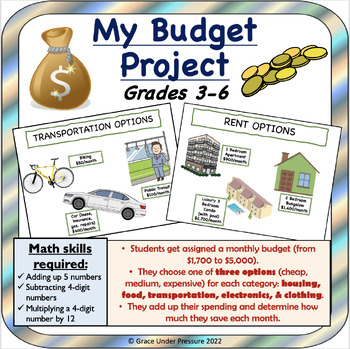Household Budget: Elementary Students: Financial Literacy 3rd Grade to 6th Grade
Grace Under Pressure
326 Followers
Grade Levels
3rd - 6th, Homeschool
Subjects
Resource Type
Standards
CCSS3.NBT.A.2
CCSS4.NBT.B.4
CCSS5.NBT.B.5
CCSSMP4
Formats Included
- PDF
- Easel Activity
Pages
10 pages
Grace Under Pressure
326 Followers
Easel Activity Included
This resource includes a ready-to-use interactive activity students can complete on any device. Easel by TPT is free to use! Learn more.
What educators are saying
This helped my students to see the importance of making sure they were responsible with their money.
My students absolutely loved this project! they have requested more like it! It was fun watching my 3rd graders try to reason why they needed what they chose!!
Also included in
- This bundle includes everything you need to introduce your elementary students in grades 3-6 to important financial literacy topics! They will create a household budget by choosing options for food, transportation, housing, clothing, etc. They will learn how a bank account works by playing a boardPrice $10.00Original Price $13.75Save $3.75
Description
Here’s a fun and realistic way to teach elementary students in 3rd grade to 6th grade about budgeting and financial literacy! Each student gets assigned a monthly budget amount (from $1,700 to $5,000). They choose one of three options (cheap, medium, expensive) for each category: housing, food, transportation, electronics, & clothing.
They add up their spending and determine how much they save each month (and year).
They choose what luxury item they would save up for.
This lesson is full of bright and fun visuals and organized charts to ensure that the math is accessible to as many students as possible!
Math skills required:
- Adding up 5 different numbers (into the thousands place value)
- Subtracting 4-digit numbers
- Multiplying a 4-digit number by 12 to find a yearly amount
Total Pages
10 pages
Answer Key
N/A
Teaching Duration
1 hour
Report this resource to TPT
Reported resources will be reviewed by our team. Report this resource to let us know if this resource violates TPT’s content guidelines.
Standards
to see state-specific standards (only available in the US).
CCSS3.NBT.A.2
Fluently add and subtract within 1000 using strategies and algorithms based on place value, properties of operations, and/or the relationship between addition and subtraction.
CCSS4.NBT.B.4
Fluently add and subtract multi-digit whole numbers using the standard algorithm.
CCSS5.NBT.B.5
Fluently multiply multi-digit whole numbers using the standard algorithm.
CCSSMP4
Model with mathematics. Mathematically proficient students can apply the mathematics they know to solve problems arising in everyday life, society, and the workplace. In early grades, this might be as simple as writing an addition equation to describe a situation. In middle grades, a student might apply proportional reasoning to plan a school event or analyze a problem in the community. By high school, a student might use geometry to solve a design problem or use a function to describe how one quantity of interest depends on another. Mathematically proficient students who can apply what they know are comfortable making assumptions and approximations to simplify a complicated situation, realizing that these may need revision later. They are able to identify important quantities in a practical situation and map their relationships using such tools as diagrams, two-way tables, graphs, flowcharts and formulas. They can analyze those relationships mathematically to draw conclusions. They routinely interpret their mathematical results in the context of the situation and reflect on whether the results make sense, possibly improving the model if it has not served its purpose.







